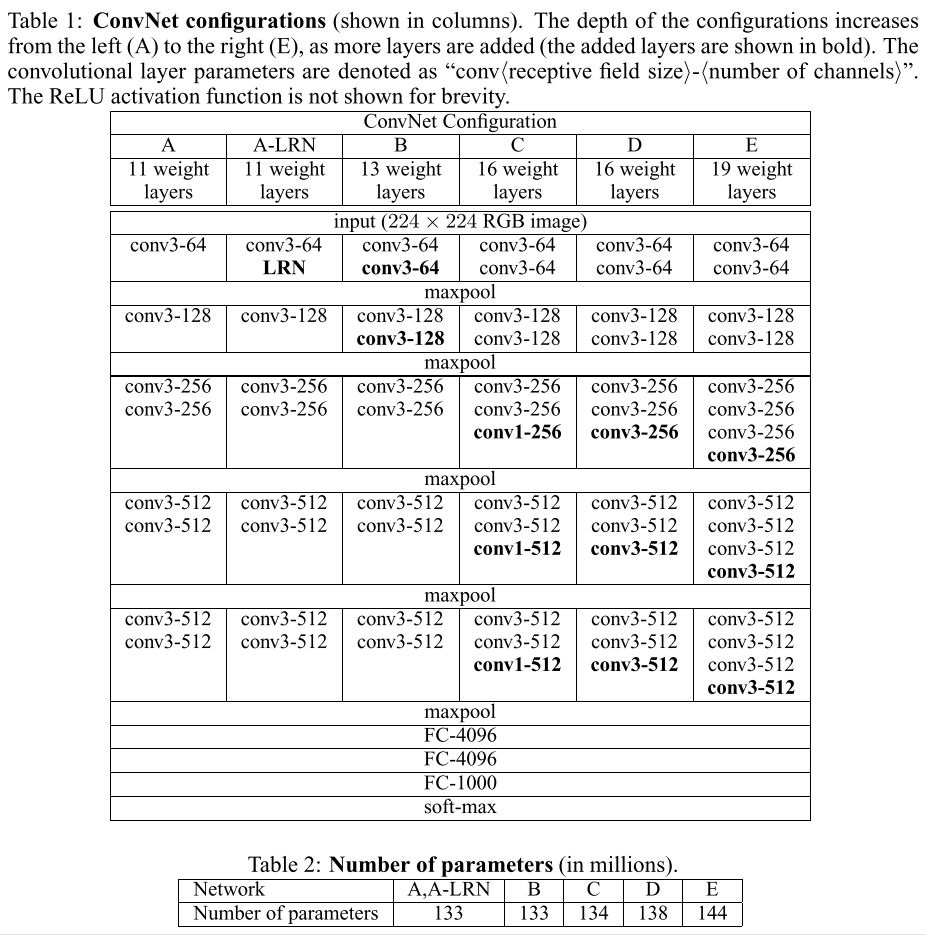VGG网络的Pytorch实现
1.文章原文地址
Very Deep Convolutional Networks for Large-Scale Image Recognition
2.文章摘要
在这项工作中,我们研究了在大规模的图像识别数据集上卷积神经网络的深度对准确率的影响。我们主要贡献是使用非常小(3×3)卷积核的架构对深度增加的网络进行全面的评估,其结果表明将深度增大到16-19层时网络的性能会显著提升。这些发现是基于我们在ImageNet Challenge 2014的目标检测和分类任务分别获得了第一名和第二名的成绩而得出的。另外该网络也可以很好的推广到其他数据集上,在这些数据集上获得了当前最好结果。我们已经公开了性能最佳的ConvNet模型,为了促进在计算机视觉中使用深度视觉表征的进一步研究。
3.网络结构

4.Pytorch实现
import torch.nn as nn
try:
from torch.hub import load_state_dict_from_url
except ImportError:
from torch.utils.model_zoo import load_url as load_state_dict_from_url __all__ = [
'VGG', 'vgg11', 'vgg11_bn', 'vgg13', 'vgg13_bn', 'vgg16', 'vgg16_bn',
'vgg19_bn', 'vgg19',
] model_urls = {
'vgg11': 'https://download.pytorch.org/models/vgg11-bbd30ac9.pth',
'vgg13': 'https://download.pytorch.org/models/vgg13-c768596a.pth',
'vgg16': 'https://download.pytorch.org/models/vgg16-397923af.pth',
'vgg19': 'https://download.pytorch.org/models/vgg19-dcbb9e9d.pth',
'vgg11_bn': 'https://download.pytorch.org/models/vgg11_bn-6002323d.pth',
'vgg13_bn': 'https://download.pytorch.org/models/vgg13_bn-abd245e5.pth',
'vgg16_bn': 'https://download.pytorch.org/models/vgg16_bn-6c64b313.pth',
'vgg19_bn': 'https://download.pytorch.org/models/vgg19_bn-c79401a0.pth',
} class VGG(nn.Module): def __init__(self, features, num_classes=1000, init_weights=True):
super(VGG, self).__init__()
self.features = features
self.avgpool = nn.AdaptiveAvgPool2d((7, 7)) #固定全连接层的输入
self.classifier = nn.Sequential(
nn.Linear(512 * 7 * 7, 4096),
nn.ReLU(True),
nn.Dropout(),
nn.Linear(4096, 4096),
nn.ReLU(True),
nn.Dropout(),
nn.Linear(4096, num_classes),
)
if init_weights:
self._initialize_weights() def forward(self, x):
x = self.features(x)
x = self.avgpool(x)
x = x.view(x.size(0), -1)
x = self.classifier(x)
return x def _initialize_weights(self):
for m in self.modules():
if isinstance(m, nn.Conv2d):
nn.init.kaiming_normal_(m.weight, mode='fan_out', nonlinearity='relu')
if m.bias is not None:
nn.init.constant_(m.bias, 0)
elif isinstance(m, nn.BatchNorm2d):
nn.init.constant_(m.weight, 1)
nn.init.constant_(m.bias, 0)
elif isinstance(m, nn.Linear):
nn.init.normal_(m.weight, 0, 0.01)
nn.init.constant_(m.bias, 0) def make_layers(cfg, batch_norm=False):
layers = []
in_channels = 3
for v in cfg:
if v == 'M':
layers += [nn.MaxPool2d(kernel_size=2, stride=2)]
else:
conv2d = nn.Conv2d(in_channels, v, kernel_size=3, padding=1)
if batch_norm:
layers += [conv2d, nn.BatchNorm2d(v), nn.ReLU(inplace=True)]
else:
layers += [conv2d, nn.ReLU(inplace=True)]
in_channels = v
return nn.Sequential(*layers) cfgs = {
'A': [64, 'M', 128, 'M', 256, 256, 'M', 512, 512, 'M', 512, 512, 'M'],
'B': [64, 64, 'M', 128, 128, 'M', 256, 256, 'M', 512, 512, 'M', 512, 512, 'M'],
'D': [64, 64, 'M', 128, 128, 'M', 256, 256, 256, 'M', 512, 512, 512, 'M', 512, 512, 512, 'M'],
'E': [64, 64, 'M', 128, 128, 'M', 256, 256, 256, 256, 'M', 512, 512, 512, 512, 'M', 512, 512, 512, 512, 'M'],
} def _vgg(arch, cfg, batch_norm, pretrained, progress, **kwargs):
if pretrained:
kwargs['init_weights'] = False
model = VGG(make_layers(cfgs[cfg], batch_norm=batch_norm), **kwargs)
if pretrained:
state_dict = load_state_dict_from_url(model_urls[arch],
progress=progress)
model.load_state_dict(state_dict)
return model def vgg11(pretrained=False, progress=True, **kwargs):
"""VGG 11-layer model (configuration "A")
Args:
pretrained (bool): If True, returns a model pre-trained on ImageNet
progress (bool): If True, displays a progress bar of the download to stderr
"""
return _vgg('vgg11', 'A', False, pretrained, progress, **kwargs) def vgg11_bn(pretrained=False, progress=True, **kwargs):
"""VGG 11-layer model (configuration "A") with batch normalization
Args:
pretrained (bool): If True, returns a model pre-trained on ImageNet
progress (bool): If True, displays a progress bar of the download to stderr
"""
return _vgg('vgg11_bn', 'A', True, pretrained, progress, **kwargs) def vgg13(pretrained=False, progress=True, **kwargs):
"""VGG 13-layer model (configuration "B")
Args:
pretrained (bool): If True, returns a model pre-trained on ImageNet
progress (bool): If True, displays a progress bar of the download to stderr
"""
return _vgg('vgg13', 'B', False, pretrained, progress, **kwargs) def vgg13_bn(pretrained=False, progress=True, **kwargs):
"""VGG 13-layer model (configuration "B") with batch normalization
Args:
pretrained (bool): If True, returns a model pre-trained on ImageNet
progress (bool): If True, displays a progress bar of the download to stderr
"""
return _vgg('vgg13_bn', 'B', True, pretrained, progress, **kwargs) def vgg16(pretrained=False, progress=True, **kwargs):
"""VGG 16-layer model (configuration "D")
Args:
pretrained (bool): If True, returns a model pre-trained on ImageNet
progress (bool): If True, displays a progress bar of the download to stderr
"""
return _vgg('vgg16', 'D', False, pretrained, progress, **kwargs) def vgg16_bn(pretrained=False, progress=True, **kwargs):
"""VGG 16-layer model (configuration "D") with batch normalization
Args:
pretrained (bool): If True, returns a model pre-trained on ImageNet
progress (bool): If True, displays a progress bar of the download to stderr
"""
return _vgg('vgg16_bn', 'D', True, pretrained, progress, **kwargs) def vgg19(pretrained=False, progress=True, **kwargs):
"""VGG 19-layer model (configuration "E")
Args:
pretrained (bool): If True, returns a model pre-trained on ImageNet
progress (bool): If True, displays a progress bar of the download to stderr
"""
return _vgg('vgg19', 'E', False, pretrained, progress, **kwargs) def vgg19_bn(pretrained=False, progress=True, **kwargs):
"""VGG 19-layer model (configuration 'E') with batch normalization
Args:
pretrained (bool): If True, returns a model pre-trained on ImageNet
progress (bool): If True, displays a progress bar of the download to stderr
"""
return _vgg('vgg19_bn', 'E', True, pretrained, progress, **kwargs)
参考
https://github.com/pytorch/vision/tree/master/torchvision/models
VGG网络的Pytorch实现的更多相关文章
- ResNet网络的Pytorch实现
1.文章原文地址 Deep Residual Learning for Image Recognition 2.文章摘要 神经网络的层次越深越难训练.我们提出了一个残差学习框架来简化网络的训练,这些 ...
- VGG网络
VGG论文给出了一个非常振奋人心的结论:卷积神经网络的深度增加和小卷积核的使用对网络的最终分类识别效果有很大的作用.记得在AlexNet论文中,也做了最后指出了网络深度的对最终的分类结果有很大的作用. ...
- 第二十四节,TensorFlow下slim库函数的使用以及使用VGG网络进行预训练、迁移学习(附代码)
在介绍这一节之前,需要你对slim模型库有一些基本了解,具体可以参考第二十二节,TensorFlow中的图片分类模型库slim的使用.数据集处理,这一节我们会详细介绍slim模型库下面的一些函数的使用 ...
- 关于VGG网络的介绍
本博客参考作者链接:https://zhuanlan.zhihu.com/p/41423739 前言: VGG是Oxford的Visual Geometry Group的组提出的(大家应该能看出VGG ...
- 基于深度学习的人脸识别系统(Caffe+OpenCV+Dlib)【三】VGG网络进行特征提取
前言 基于深度学习的人脸识别系统,一共用到了5个开源库:OpenCV(计算机视觉库).Caffe(深度学习库).Dlib(机器学习库).libfacedetection(人脸检测库).cudnn(gp ...
- 群等变网络的pytorch实现
CNN对于旋转不具有等变性,对于平移有等变性,data augmentation的提出就是为了解决这个问题,但是data augmentation需要很大的模型容量,更多的迭代次数才能够在训练数据集合 ...
- U-Net网络的Pytorch实现
1.文章原文地址 U-Net: Convolutional Networks for Biomedical Image Segmentation 2.文章摘要 普遍认为成功训练深度神经网络需要大量标注 ...
- GoogLeNet网络的Pytorch实现
1.文章原文地址 Going deeper with convolutions 2.文章摘要 我们提出了一种代号为Inception的深度卷积神经网络,它在ILSVRC2014的分类和检测任务上都取得 ...
- AlexNet网络的Pytorch实现
1.文章原文地址 ImageNet Classification with Deep Convolutional Neural Networks 2.文章摘要 我们训练了一个大型的深度卷积神经网络用于 ...
随机推荐
- sonar:查询全部项目的bug和漏洞总数(只查询阻断/严重/主要级别)
1.统计所有项目主要以上的漏洞和bug -- 统计所有项目主要以上的漏洞和bug ,) AND severity IN('BLOCKER','CRITICAL','MAJOR') 2.统计所有某个项目 ...
- linux 安装 rpm 的jdk
1.下载 JDK 路径:http://www.oracle.com/technetwork/java/javase/downloads/jdk7-downloads-1880260.html 下载 j ...
- C# 基于Directshow.Net lib库 USB摄像头使用DirectShow.NET获取摄像头视频流
https://blog.csdn.net/u010118312/article/details/91766787 https://download.csdn.net/download/u010118 ...
- LVS-TUN模式
TUN模式: 其实数据转发原理和上图是一样的,不过这个我个人认为主要是位于不同位置(不同机房):LB是通过隧道进行了信息传输,虽然增加了负载,可是因为地理位置不同的优势,还是可以参考的一种方案: 优点 ...
- qt QML弹出新页面之后,如何屏蔽上一个页面的按钮区域事件
Rectangle{ //Rectangle是要显示的新页面 //增加一个mouseArea:,必须好把MouseArea作为第一个子元素,如果放在最后且不设置z属性的话,会覆盖其//他控件 Mous ...
- [.Net] 一句话Linq(递归查询)
功能查询起止日期范围内连续的月份列表. /* Period */ cbxPeriod.DataSource = Enumerable.Range(, ).Select(t => DateTime ...
- JDK1.8 的 HashMap 源码之注意事项
文章目录 链表变树 树形结构与Comparable,性能极致与降低 链表与树之间转换的阈值 英语渣靠着翻译插件,大概翻译的,难免有错误之处,注意甄别: 链表变树 This map usually ac ...
- C++进行字母大小写转换
#include <iostream> #include <Windows.h> #include <string> using namespace std; in ...
- 写Markdown博客时遇到的一些问题
成对的美元符号$,无法转义 相同的文本,就因为成对的$(美元符号),上面显示成了公式(Math)-而且还无法转义!下面用单行代码(``)-键盘"1"左侧的键,显示就正常了 下图方法 ...
- python pip命令安装相当于yum仓库
进入pip目录: 创建pip.conf: 打开pip.conf [global] index-url=https://mirrors.aliyun.com/pypi/simple/ trusted-h ...
